Representation of Cartesian product of sets
I. Arrow diagram:
We may represent the Cartesian product of the sets by an arrow diagram.
Ex1:
If A = {3, 4, 5} and B = {6, 8, 10}, then represent A × B in an arrow diagram.
Sol:
Given, A = {3, 4, 5} and B = {6, 8, 10}.
Here, n(A) = 3 and n(B) = 3.
Here, n(A) = 3 and n(B) = 3.
 A × B
= {3, 4, 5} × {6,
8, 10}
A × B
= {3, 4, 5} × {6,
8, 10}Now the arrow diagram for A × B is as follows:
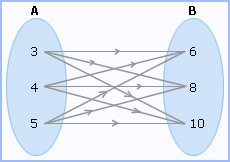
From the above diagram, we can conclude the ordered pairs as:

 A × B =
{(3, 6), (3, 8), (3, 10),
(4, 6), (4, 8), (4, 10), (5, 6), (5, 8), (5, 10)}
A × B =
{(3, 6), (3, 8), (3, 10),
(4, 6), (4, 8), (4, 10), (5, 6), (5, 8), (5, 10)}
 n(A
× B) = 9
n(A
× B) = 9Ex2:
If A = {p, q} and B = {k}, then represent A × B in an arrow diagram?
Sol:
Given, A = {p, q} and B = {k}.
 n(A) = 2,
n(B) = 1.
n(A) = 2,
n(B) = 1. n(A
× B) = 2 × 1 =
2
n(A
× B) = 2 × 1 =
2Now the arrow diagram for A × B is as follows:
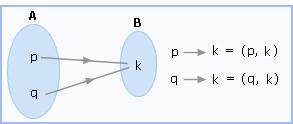 From the
above diagram, we can conclude the set of ordered pairs as:
From the
above diagram, we can conclude the set of ordered pairs as:

 A × B = {p, q} ×
{k} = {(p, k), (q, k)}
A × B = {p, q} ×
{k} = {(p, k), (q, k)}II. Tree diagram:
We may represent the Cartesian product of the sets by a tree diagram.
Ex1:
Let P = {a, b, c} and Q = {m, n} be two sets. Represent P × Q in a tree diagram.
Sol:
Given, P = {a, b, c} and Q = {m, n}.
 n(P) =
3, n(Q) = 2.
n(P) =
3, n(Q) = 2. n(P
× Q) = 3 × 2 = 6
n(P
× Q) = 3 × 2 = 6Now the tree diagram for P × Q is as follows:
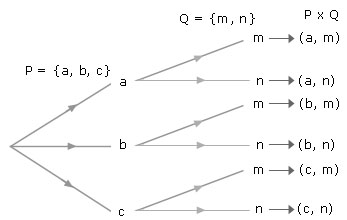
From the above diagram:
P × Q =
{a, b, c} × {m, n}
 P × Q
= {(a, m), (b, m), (c,
m), (a, n), (b, n), (c, n)}.
P × Q
= {(a, m), (b, m), (c,
m), (a, n), (b, n), (c, n)}.Ex2:
From the following tree diagram, find A × B.
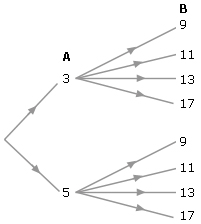
Sol:
From above diagram, we can conclude that
A = {3, 5} and B = {9, 11, 13, 17}
 n(A) = 2
and n(B) = 4
n(A) = 2
and n(B) = 4 n(A
× B) = 2 × 4 = 8
n(A
× B) = 2 × 4 = 8 A
× B = {3, 5} × {9,
11, 13, 17}
A
× B = {3, 5} × {9,
11, 13, 17} A × B
= {(3, 9), (3, 11), (3,
13), (3, 17), (5,9), (5, 11), (5, 13), (5, 17)}
A × B
= {(3, 9), (3, 11), (3,
13), (3, 17), (5,9), (5, 11), (5, 13), (5, 17)}III. Graphical representation of Cartesian product:
The Cartesian product can be represented in a graphical form.
Example:
If A = {1, 2, 3, 4} and B = {1, 2, 3}, then
represent A × B in a graph.
Procedure:
Draw two lines one horizontal line and vertical line which are perpendicular to each other.
Represent the first set elements 1, 2, 3, 4 on horizontal line and represent the second set elements 1,
2, 3 on vertical line.
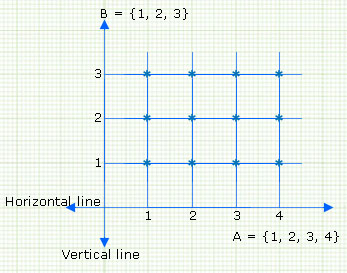
Draw lines 1, 2, 3 which are parallel to the horizontal line.
Similarly draw lines from 1, 2, 3, 4 which are parallel to vertical line.
The intersection of vertical line and horizontal line are represented as '*'.
The '*' represents the ordered pairs of the set A × B.
So, from the graph, the ordered pairs are:
(1, 1), (1, 2), (1, 3), (2, 1), (2, 2), (2, 3), (3, 1), (3, 2), (3, 3), (4, 1), (4, 2), (4, 3)
∴ The set A × B =
{(1, 1), (1, 2), (1, 3), (2, 1), (2, 2), (2, 3), (3, 1), (3, 2), (3, 3), (4, 1), (4, 2), (4,
3)}